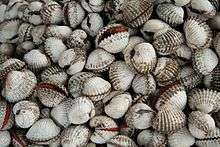Tegillarca granosa
| Tegillarca granosa | |
|---|---|
 | |
| Scientific classification | |
| Kingdom: | Animalia |
| Phylum: | Mollusca |
| Class: | Bivalvia |
| Subclass: | Pteriomorphia |
| Order: | Arcoida |
| Family: | Arcidae |
| Genus: | Tegillarca |
| Species: | T. granosa |
| Binomial name | |
| Tegillarca granosa Linnaeus, 1758[1] | |
| Synonyms | |
| |
Tegillarca granosa (also known as Anadara granosa[2]) is a species of ark clam known as the blood cockle or blood clam due to the red haemoglobin liquid inside the soft tissues. It is found throughout the Indo-Pacific region from the eastern coast of South Africa northwards and eastwards to Southeast Asia, Australia, Polynesia, and up to northern Japan. It lives mainly in the intertidal zone at one to two metres water depth, burrowed down into sand or mud. Adult size is about 5 to 6 cm long and 4 to 5 cm wide.[3]
It has a high economic value as food, and it is kept in aquaculture. Just on the coast of Zhejiang Province alone, blood cockle plantations occupy around 145,000 mu (about 100 km2) of mudflats.[5] These clams are raised in the river estuaries of the neighboring Fujian Province as well.[4]
The meat of this bivalve is served steamed, boiled, roasted, or traditionally raw.
Safety
Unlike other varieties of clams that are safe to eat, the blood clam lives in low-oxygen environments, and thus ingests more viruses and bacteria, including hepatitis A, hepatitis E, typhoid, and dysentery, to get the nutrients it needs.[6]
Although blood clams are considered one of the more delicious Chinese delicacies, the style of preparation in Shanghai involves quick-boiling them, leaving many of the viruses and bacteria present.[7]
References
- ↑ "Tegillarca granosa (Linnaeus, 1758)". World Register of Marine Species. Retrieved 24 January 2016.
- ↑ (pata de mula)SPECIES: Tegillarca granosa (Malaysian cockle)(Anadara granosa)
- ↑ Pathansali, D. (1966). Notes on the biology of the cockle, Anadara granosa L. Proc. Indo-Pacific Fish. Counc. 11:84-98
- 1 2 Ruǎn Jīnshān; Li Xiùzhū; Lín Kèbīng; Luō Dōnglián; Zhōu Chén; Cài Qīnghǎi (阮金山;李秀珠;林克冰;罗冬莲;周宸;蔡清海), 安海湾南岸滩涂养殖贝类死亡原因调查分析 (Analysis of the causes of death of farmed shellfish on the mudflats in the southern part of Anhai Bay), 《福建水产》 (Fujian Aquaculture), 2005-04
- ↑ 泥蚶抗高氨氮、高硫化物家系选育 (Breeding mud cockle varieties resistant to high-nitrogen, high-sulfide environment). (The numbers are as of 2009)
- ↑ http://www.msn.com/en-nz/foodanddrink/foodnews/15-most-dangerous-foods-in-the-world/ss-BBadz6H#image=14
- ↑ http://en.people.cn/90882/8339655.html
- Huber, M. (2010). Compendium of bivalves. A full-color guide to 3,300 of the world’s marine bivalves. A status on Bivalvia after 250 years of research. Hackenheim: ConchBooks. 901 pp., 1 CD-ROM
External links
| Wikimedia Commons has media related to Tegillarca granosa. |